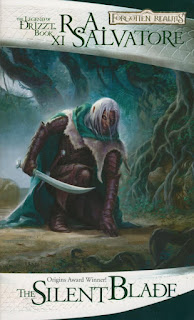Shadowdale is the first of the Avatar Series, what was originally a trilogy but later expanded to five books. It was written by Scott Ciencin though originally published under the pen name Richard Awlinson. There is an Advanced Dungeons & Dragons Module of the same name that corresponds with the events of the book.
This review has corresponding video which you can watch here.
 |
| Original cover |
The story starts with the gods and goddesses of the Forgotten Realms gathered together by Lord Ao. They are the target of his wrath for some of them have stolen the tablets of Fate. As a result, the Avatar crisis ensues as the gods are cut off from their realms and godhood, so prayers and magic go unanswered and become unreliable, while the gods are made to walk the planet Toril in mortal avatar form. The only one not cast down is Helm, God of Guardians.
The year is 1358 DR and so begins the Time of Troubles, also called the Arrival, the Godswar, and the Avatar Crisis. This is also the beginning of the Era of Upheavel which will end over 100 years later with the Second Sundering.
With the deities casting out, we first see Mystra, goddess of magic, try to access the Weave, yet deification form at which all magic of the Art comes, and she fails. Then Bane, god of hate, terror, and tyrannical oppression, lands in Zhentil Keep and takes and avatar as he sets about his malevolent plan to acquire the Tablets of Fate.
Near the city of Arabel in Cormyr, the mage Midnight awakens to find things not as she left them, most notably she has a strange amulet around her neck. Her and 3 other heroes find themselves im the midst of the power struggle of the deities and their minions.
One of the others is Kelemvor a sellsword warrior also in Arabel during the events of the Arrival. He is a little moody and not much of a people person, but still honorable and pretty average in his temperament besides his glaring misogyny, which is kinda out of place in the Forgotten Realms. He is acquainted with Cyric as they recently went after the artifact The Ring of Winter. He is approached by a starving waif on the streets who seems to have a quest in a mind for him.
 |
| Reprint cover |
Cyric is a thief turned mercenary. Honestly my favorite character, which is funny if you know what becomes of him.
Then we have Adon, à Cleric of Sune Firehair, goddess of Beauty. He is familiar with Cyric and Kelemvor as he was also used by Lady Lord Myrmeen Lhal, ruler of Arabel to bring down a conspiracy. Adon is certainly vain and a little arrogant and foolish.
I found Ciencin’s descriptions of simple character actions to be written perfectly, where I was getting imagery for mundane things I often don’t get while reading. The characters all decently explored too, for example finding out more about Kelemvor’s past, and how his curse really harms his temperament.
The pacing is a little slow, for example chapter 6 is somewhat dreamlike and dragging. Chapter 7 fixes this.
There are a decent amount of deities talked about with only the most basic of descriptions, so those unfamiliar with the pantheon be lost with the mention of gods and goddesses.
Divine magic only works for clerics within a mile of their deities avatars, while arcane magic that normally comes from Mystra, Goddess of Magic and her weave is terrible inconsistent and dangerous to use.
The gods most at play here are Mystra, Bane, Helm, and Myrkul Lord of the Dead. This conflict really gets heated about the halfway point and that made the book finally hold more of my attention.
As the back of the book states, the party wants to eventually get to Elminster in Shadowdale, hence the title of the book. Those two things had me thinking a majority of the book in Shadowdale, but only the last bit actually is. The party goes from Arabel to Castle Kilgrave, to Tilverton, to Shadow Gap, to Spiderhaunt Woods before reaching the titular place.
There is a romantic relationship I didn’t really care for as one of the people in the relationship wasn’t really a good prospect.
The story does end with a cliffhanger that left me saying what the heck. Overall it’s Good, though maybe barely so. I have not been itching too bad to get to the next book, but I am looking forward to how the story develops.




























